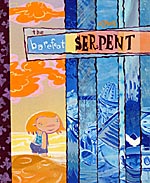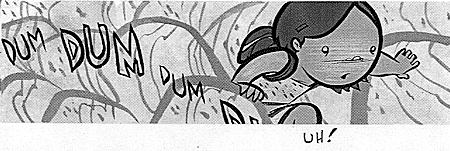 By Scott Morse
By Scott Morse
128 pages, black and white, and color
Published by Top Shelf Productions
The trick to a homage, really, is making sure it works without understanding the homage. No, think about it. If you’re going to pay homage to a great influence or idea, that’s super. But what happens when people who haven’t encountered the original work? I think that’s one of the things that stood out the most to me when reading The Barefoot Serpent; even if you don’t catch all (or any!) of the allusions to Akira Kurosawa’s films, you’re still going to enjoy it on its own merits.
A family in need of healing travels to Hawaii to try and get over their losses. It’s not until they each go out on their own, though, that they’ll start being able to truly understand their feelings of depression, and how they can be with each other once more. At the same time, though, they do not see that their own story contains echoes of another person’s life story… one who touched many people’s lives as well.

It’s a daunting task, to come up with a children’s book that contains homages and references to the films of Kurosawa, and to be honest I found myself wondering if it was really going to work. Morse is careful to keep it much more in the background, though, using the glimpses as more of a level of mystique about the book. As the young girl gets to see the other side of Hawaii, things like the hungry pool or the floating drummers are wonderfully evocative images that Morse puts into the book, and they fit with the general mood of the book that he’s created. It wasn’t until reading the author’s notes that I discovered what they were references to, but I don’t feel like I missed out on the experience as a reader. In the end, you understand the heart of the story, and will definitely be moved by it.

Morse’s art is a real treat in The Barefoot Serpent. While the majority of the book is told in a three-panel layout of painted black and white art, it’s bookended with gorgeous full-color paintings about the life of Kurosawa. It’s a great contrast, moving from the glorious color that was Kurosawa’s life to the muted black and white tones of the grieving family. Like most of Morse’s books, his children are cute as buttons, and it’s fun to just look at the individual paintings that make up a page and look at each line and shade of gray. The format of the black and white portion of the book works really well in terms of storytelling; it reminds me a lot of how many children’s books are set up, with the words underneath the images and working across the page in a simple progression.

With grin-inducing dialogue and a rich tapestry of art on display, The Barefoot Serpent brings me in mind of Morse’s Soulwind, which first alerted everyone to Morse’s considerable talents. He’s able to mix so many different elements together seamlessly, and this is a book that will work on a number of different levels to different people, but the common element is that everyone is going to get a great deal of joy from it. Top Shelf’s recent publications have been some of their strongest to date, and The Barefoot Serpent is no exception. You can find the order solicitation in the current Previews for a September 2003 release date, on page 362, and is Diamond code JUL03 2515. Order this book.
